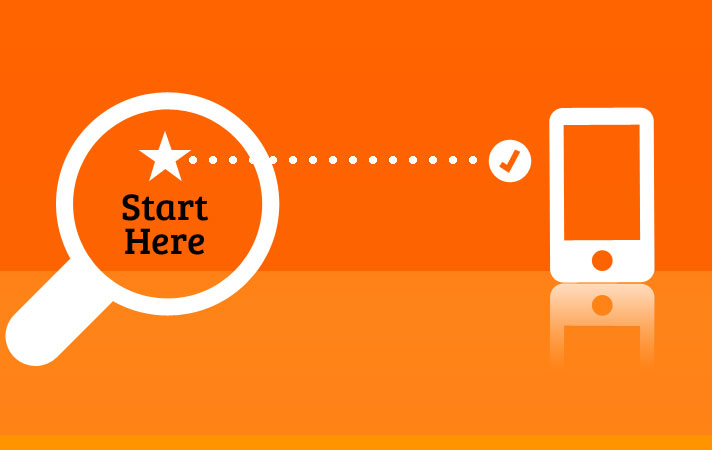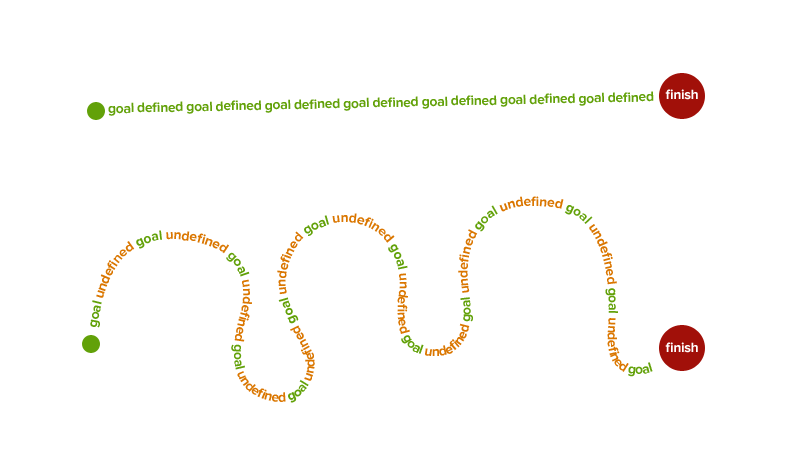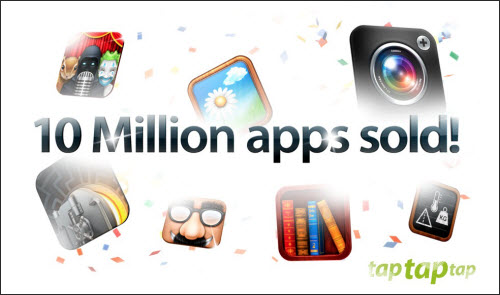How To Create Your First iPhone App (2012 Edition)
Update: 01/10/2012: The original version of this article by Jen Gordon was published in August 2009. It was thoroughly revised and updated by the author in September 2012. — Editorial Team
Since the iTunes App Store launched in 2008, over 500,000 apps have been approved by Apple, and thousands more app ideas are scrawled on napkins across the world every day. But question remains, how can a person with limited technical skills create an iPhone app?
Be sure to check out our previous articles:
- Web Development For The iPhone And iPad: Getting Started
- iPhone App Design Trends
- iPhone Apps Design Mistakes: Disregard Of Context
- iPhone Apps Design Mistakes: Over-Blown Visuals
The good news is anyone can make an iPhone app, it’s just a matter of knowing the series of actions you need to take to make it happen. Be sure to bookmark this article because it will serve as a guide for learning the process for creating your first iPhone app, going step by step from idea to the App Store.

What Is Your Goal?
The first thing to look at when embarking on any product development or entrepreneurial venture is your goals for the project. Having a vision of what you want to achieve at the outset is an important barometer that will confirm whether the development process is heading in the right direction.

Let’s look at an example. Jim is an “idea person” who wants to create an app that brings in passive income but that doesn’t require him to quit his day job. Jim understands that to achieve this goal, he will need to employ others who can do the work of updating the app, fielding customer questions, responding to feature requests, etc. If Jim hadn’t defined this goal in advance, it’s likely that he:
- would not have planned in advance to hire help,
- would be unhappy with the time commitment required for him to take on the work personally.
Whether you’re an individual like Jim, a marketing director, or an IT professional creating apps for internal use, having a project goal will help make your app development process a success.
Here are some examples of project goals:
- Create an app that doesn’t require hands-on day-to-day management.
- Create an app that becomes a full-time business for me and a team.
- Create an app that promotes my existing product or service.
- Create an app that is purely for fun and not for profit.
Action item: Write down the goal you hope to achieve by creating this app.
What Are Your Expectations?
When I consult with people who have ideas for iPhone and iPad apps, the question they most frequently ask is, “How much can I expect to make?” Unfortunately, this is difficult to answer. The following factors are unique for each application:
- Cost to produce,
- Popularity,
- People responsible for managing its success.
All of these factors contribute to the financial success of your app. Base your expectations on this knowledge and on the documented proof that a wide variety of people are making profitable apps every day:
- Non-technical “idea people” and entrepreneurs such as the Gabi founders;
- Independent developers such as Lima Sky and Driftlab;
- Educators such as Montessorium;
- Writers such as Sarah Young;
- Mid-size entertainment companies such as Electronic Arts and Zynga;
- Large sports and entertainment companies such as MLB and Disney.
Realistic revenue projections will be different for each app, but here’s an example:
ABC application will show a profit of 10% in the first 60 days after launch, based on the success of XYZ application, which has a similar user base and functionality.
Individuals and companies alike are creating apps to solve problems and to entertain, and yet the process of making apps is still cloaked in mystery. Next, we’ll look at what goes on behind the scenes of an app’s creation and give you a step-by-step process for making your own idea a reality.
Where Do I Begin?
Good advice on where to start is different today than it was two years ago, when you could launch an app without much promotion and still have a fair shot at getting seen. Today, App Store competition is fierce, and dozens of new high-quality apps are being launched every day. This competitive environment means that ideas must be evaluated and refined to achieve maximum success in the App Store.
Have your idea evaluated. “Evaluating” anything in which you are not an expert is difficult. For example, if someone had an idea for an innovative design for a child’s car seat, would that person be qualified to evaluate their own idea? Probably not. They would need to seek out the advice of someone who knows the child car seat niche. That expert would shed light on how to make the idea even better based on their specialized knowledge of the industry.
The app world is no different, and a variety of people are qualified to evaluate ideas:
- iPhone app marketing professionals. These people have specialized knowledge of how their clients’ apps have performed in the App Store, as well as of promotional techniques that do and don’t work.
- iPhone app developers Many successful indie developers are committed to serving their community. If you humbly approach these folks for advice, in my experience most are more than happy to help review your idea.
- Personal connection. Do you know someone personally who has created and launched an app? Take them out for lunch and have them give feedback on your idea.
What will an evaluation do for me? When you get an expert opinion on your idea, you find out the following:
- Whether the product will have competition that will be tough to beat;
- Whether the idea has any technical limitations;
- How to take a phased approach to the development process;
- Whether you can refine the idea in other ways to increase sales opportunities;
- Whether the idea could be profitable based on your ballpark estimate of production costs;
- Whether the idea is a good fit for the mobile context;
- Whether your target audience could provide useful feedback on the idea.
This is the type of information you want to gather from an expert reviewer. Once you’ve met with someone who can give you this kind of feedback, you can move on to the next steps of the project with confidence in the viability of your idea and that your goals can be met.
What if I can’t find someone to evaluate my idea? If you’re having difficulty finding an expert to provide an opinion on your idea, ask yourself whether these success factors apply to your app:
- Does your app solve a unique problem? People want to be able to do a lot of things while on the go. Successful apps often solve a problem that is unique to the mobile context.
- Does the app serve a niche? Find a niche with ardent fans (pet lovers, for example), and create an app that caters to it.
- Does it make people laugh? This is a no-brainer. What happens with funny apps? They get shared — a lot.
- Are you building a better wheel? Are there existing successful apps that lack important features or design elements? This is tricky because those developers might already be working on such enhancements. But if you get to market first, you have a good shot.
- Will the app be highly interactive? Let’s face it: most of us have the attention span of a flea. Successful games and utilities engage the user by requiring a lot of fast-paced interaction.
Action item: Have your idea evaluated.
Step 1: Develop A Monetization And Marketing Plan
“Wait a second, aren’t we supposed to be drawing prototypes and stuff?” Actually, not yet. The next step before moving into any kind of design or development is to figure out how your idea will generate a profit!
“Why is this so important? Can’t I do it later?”
You could, but AppPromo surveyed 102 developers and announced in its report that:
80% are NOT generating enough revenue with their app to support a standalone business.
It’s fair to assume that a great portion of that 80% also didn’t develop a monetization or marketing plan prior to developing their app. Read tap tap tap’s blog to see how companies like it do their homework. The results speak for themselves:
 Large view.
Large view.Here’s what you have to look forward to if you do not consider monetization strategies before developing your app:
“OMG I’ve got this great idea!”Sketch, sketch, sketch.
Design.
Develop.
“I think I’ll charge 99¢. See how that goes.”
Launch. “Woo hoo!”
“Uh oh. Why aren’t people paying 99¢?!?”
App plummets into App Store black hole.
“Maybe I should make it free?!?”
“Crap! Where’s my developer? I need to fix the app, change the way it makes money, because 99¢ isn’t working!”
“OK, the app is fixed, with a new way to make money. How am I going to get my ranking back up?”
Not pretty, but a very real scenario. If you want a step-by-step guide to avoiding the chaos of a pricing disaster, consult my “App Monetization Guide.”
Action item: Develop a monetization plan.
Step 2: Sign Up For A Developer Account
Even if you will be hiring out the development work, you will need to establish your business within the App Store. To do this, visit the iOS Development Center, and sign up for an account. It’s $99 for a year and requires that you provide the tax and bank account information of your business or yourself. Have this information handy before signing up. Large view.
The only reason not to sign up for a developer account would be if you’re OK with having your app published under another person or company’s account and brand. If that is the case, then know that Apple would pay all revenue to the account holder’s bank account. That account holder would then be responsible for paying you.
Action item: Open an iOS developer account.
Step 3: Sketch Your Application
If you have an idea already, then you likely have some visuals in mind for how the app would look and work and the information it would present. You don’t have to be an artist to sketch a rough interface, so start putting your ideas down on paper. Before you begin, ask yourself:
- What primary action will users take within the app?
- What information will each screen need to present?
- What is the flow? How will users get from start to finish?
- How big should the elements on screen be relative to each other?

Sketching your layout can be simplified with the right tools. (Image: Cultured Code)
You may find during this process that some fresh ideas come to mind that simplify the flow or that add a creative twist to the interaction design. Try to keep your original concept in mind without blocking the flow of new ideas!
Create at least one thumbnail sketch for each screen in your application. Experiment with various navigational schemes, the copy on buttons and the flow between screens. If you want to transfer your sketches into digital format, iPlotz is a good tool to check out.
The purpose of sketching your application’s screens is to build a foundation for the next phase of the project. If you’re an entrepreneur and are outsourcing the bulk of the project’s work, then you would show these sketches to the design and development team in order to get a price estimate.
Action item: Sketch out all screens of your app.
Step 4: Identify The Work To Be Outsourced
What skills do you bring to the table? Are you a designer whose brain objects to Objective C? A developer who couldn’t design their way out of a paper bag? Or simply an individual with an idea they’d like to bring to market?
When you create an iPhone application, you’re starting a small business. It is difficult for one person to play the role of researcher, project manager, accountant, information architect, designer, developer, marketer and advertiser. Can you do it all? Of course you can, but you would be wasting a lot of time, energy and sanity in the process. Based on the following list of required skills, define the areas where you would be comfortable taking the lead and where you would need to hire help:
- Design,
- Programming,
- Promotion and marketing.
In most cases, the least expensive way to produce your application would be by hiring freelance contractors. While your costs would be lower, your role as project manager would become more prominent. You would spend more time managing the moving parts of the project. Also, when working with freelancers, remember to have them sign a non-disclosure agreement or at least an employment contract, with details on the scope of their work, your expectations and payment terms.
Another option is to hire an agency or development firm to handle a large chunk of the production. In this scenario, the agency would be charged with managing the project, and your role as client would be to review and approve its work. Working with an agency is a good option if you have a larger budget and less time to dedicate to the production process.
Action item: Identify your role and the roles of those you hire.
Step 5: Hiring Your Team
In step 4, you defined which roles need to be outsourced in order to produce the app. Now it’s time to learn exactly what each of those roles will do and where to find people for your team.
Design
If you are a designer, download my “iPhone App Template,” a big collection of iPhone UI elements. These Photoshop files will save you a lot of time getting started on the design. To learn more about mobile design in general, these websites provide a lot of great resources:
- Marc Edwards’ articles
- Ken Yarmosh’s blog
- Luke Wroblewski’s blog
- DesignBoost (disclaimer: this is my mobile design training website)
- UI Stencils
If you’re not a designer, then you should know that design breaks down into three roles: information architecture, interaction design and visual design. Finding one person with all of these skills is possible, but know that the design process calls for three distinct deliverables. If you’ve got your sketches, then you have everything you need for a designer to get started.
- Information architecture. In case you’re familiar with the Web design process, “information architecture” as it relates to mobile is very similar. If you’re not familiar with the term, it simply means “organizing the content in your app.”
- Interaction design. Have you ever used an app that you didn’t need any instruction to operate? One in which the flow was so intuitive that you barely noticed the interface? It wasn’t by accident. This is the job of the interaction designer, someone who sorts out how the user will move from screen to screen to accomplish their task. Be sure to hire a designer who has skill in this area.
- Visual design. Visual design is the final step in the design process. It is the “skin” that overlays the controls for the app. The visual design can be as simple or as complex as you want; the key is to focus on the usability and primary task of the app.
Try to find a designer who has experience designing for mobile devices. They will have some good feedback and suggestions to improve your sketches. A few places to look for designers:
When posting your job offer, be very specific about your requirements, and be ready to review a lot of portfolios.
Development
If you are an Objective C or Cocoa developer, then crack open Xcode and get started! Join a few forums if you haven’t already:
- Developer Forums, Apple
- iPhoneSDK, Google Group
- StackOverflow
If you are not a developer, then get your developer on board as you’re lining up the designer. Speaking with a developer sooner than later will help you scope a project that is technically feasible and within your budget.
Finding a developer Using the sketches you’ve drawn up, compose a specification document that describes in writing what your app does and for whom. This document, along with your sketches, is what you will share with the developer to get a time and cost estimate.
Having a document like this also ensures that you will be able to hire a developer who has the skills necessary to produce the app. If you provide specifications for a game app to a developer who doesn’t have game development expertise, they will be able to quickly tell that the project isn’t a good fit.
Here are a few places to look for developers:
- Upwork
- They Make Apps
- Elance
- Any of the forums listed above for designers
Submitting your app to the App Store Your developer can also help you submit your application to the App Store. Clearly communicate the launch date of your app to the developer. Nothing is more detrimental to an app’s success than an unexpected or poorly planned launch. To learn more, read Apple’s “App Store Review Guidelines.” Also, you might want to check Average App Store Review Times and unpublished rules and clarifications from Apple’s App Review team that can cause your iPhone app to be rejected.
Marketing and Promotion
If a tree falls in the forest and nobody is around to hear it, does it make a sound? Apps can sit in the store unnoticed very easily. Don’t let this happen to you. Be ready with a plan to market your app. In fact, be ready with many plans to market your app. Be ready to experiment because some ideas will work, and others won’t.
Strategies for marketing and promotion:
- Incorporate social media. Think about how your app could incorporate social media, and build that functionality into it. At a minimum, set up fan pages for your app on Facebook and Twitter, and use them as platforms to communicate with users and get feedback. The developers of Angry Birds and Instagram do a good job of engaging users on Facebook.
- Pre-launch promotion. Start building buzz about your app before it launches. Email journalists and bloggers who write about things related to your app. The more relevant your app is to their niche, the better your chances of getting written about. Some outlets to consider:
- TUAW (The Unofficial Apple Weblog)
- Macworld
- TouchArcade
- Plan for multiple releases. Don’t pack your first release with every feature you want to offer. Create a dream list, and design the app so that it can accommodate all of these features in the future. Then periodically release new versions of the app to boost sales.
- Other sources of app marketing ideas:
- “Indie iPhone App Marketing,” Chris Hulbert, Splinter Software
- Mobile Marketer
- Mobile Marketing Watch
- “App Store Marketing,” LinkedIn group
Action item: Find freelance or agency contractors to fill the roles for design, development and marketing.
Conclusion
Transforming something as intangible as an idea into a tangible, playable, enjoyable app is an exciting venture. The most important takeaway for anyone looking to create their first iPhone app is to focus on hiring the right team to help bring your idea to fruition and to help maintain the app over time.
If you are an app developer with advice to share with first-time creators, please share in the comments below. Good luck and have fun!








